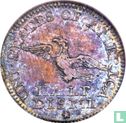

Enlarge image


Catalogue information
LastDodo number
2030765
Area
Coins
Title
United States 5 cents 1792
Country
Face value
Year
1792
Variety / overstrike
Head of State
Type
Designer
Series
Theme
Material
Gold- or silver content
Weight
Diameter
Thickness
Punch
Shape
Obverse
Portret naar links
Reverse
Arend, vliegend naar links
Edge
Privy mark
Mint mark
Number produced
Krause and Mishler number
KM#
Catalogue number
Details
The 1792 half dismes were struck very soon afterward, as on July 13, Jefferson recorded in his household account book "rec'd from the mint 1500 half dimes of the new coinage." Although various numismatic authorities have attributed the design to numerous Mint figures of the era--usually Adam Eckfeldt, Henry Voigt, and the "Birch" of the Birch cents, although sometimes David Rittenhouse himself is thrown in--it is likely that the designer's identity will never be known with absolute certainty. In the case of "Birch," he was long thought to be Robert Birch, but now William Russell Birch's name has surfaced as the prime candidate. In any case, the design may well have been a collaboration, a product of what was conceivable meeting what could be accomplished in a relatively short timeframe.
The mintage of 1792 half dismes is likewise uncertain, although 1,500 and 2,000 pieces are the most frequent surmisals, given the totality of evidence that exists (in addition to the Jefferson notation above). While numerous examples exist down to the AG grade level, relatively recent research by Joel Orosz and Carl Herkowitz, published in the 2003 American Journal of Numismatic, concludes that they were struck, not for circulation, but privately for George Washington, who distributed some of them to friends in Virginia, while others were sent to Europe. The survival rate and overall grades are consistent with presentation pieces, at least in part, and a few Mint State pieces survive.
In the case of the 1792 silver half disme the coin actually predates the U.S. Mint, at least in terms of a physical structure. The coins were, as the well-known story goes, struck in the cellar of one John Harper, a sawmaker, as a matter of convenience before the official Mint building was completed and ready for coinage. Shortly after Congress approved the Mint Act in April 1792, President Washington appointed David Rittenhouse as the first director of the Mint. His appointment date was April 14, but because of his poor health he waited until July 9 to accept the appointment, at which time he also appointed Henry Voigt as chief coiner pro tem. Rittenhouse bought a house and lot in Philadelphia, the center of government at the time, had the existing buildings demolished, and readied the first new Mint structure for operations by September.
Rittenhouse wasted no time in getting at least a small coinage under way. In his July 9 acceptance letter to George Washington, in which he detailed his purchase of the Philadelphia property on account of the United States, he also wrote:
"On consulting with the Secretary of State [Thomas Jefferson] I find that some of the Officers for the mint are still expected from Europe. This will occasion further delay, at least as to going generally into coining. But as small money is very much wanted we think proper, in the mean time, if your Excellency approves of it, to Coin some Copper Cents & Half Cents, and likewise small Silver, at least Dimes and Half Dimes. ... I have likewise engaged Mr. Voigt to act as Coiner, and he has several workmen now employed in making the necessary engines and preparing the Dies."
Courtesy to Heritage Auctions



